On Cubic Spudcan Deep Penetration in Dense Sand Overlying Non-Uniform Clay
Abstract
1. Introduction
2. Numerical Analysis
2.1. FE Modeling
2.2. Constitutive Models and Material Characteristics
2.2.1. Sand Layer
2.2.2. Clay Layer
3. Validation against Centrifuge Test Data
4. Potential of Punch-Through Failure of the Cubic Spudcan
4.1. Penetration Resistance Profile
4.2. Degree of the Post-Peak Bearing Reduction
5. Concluding Remarks
Author Contributions
Funding
Institutional Review Board Statement
Informed Consent Statement
Data Availability Statement
Acknowledgments
Conflicts of Interest
Abbreviations
| d | penetration depth of the spudcan base (lowest point at largest section) |
| D | diameter of the generic spudcan at the largest section |
| H | height of the cubic spudcan |
| ID | relative density of sand |
| k | strength gradient of clay (in kPa/m) |
| L | length of the cross-section of the cubic spudcan |
| qpeak, qpost-peak | peak and post-peak penetration resistance of the spudcan |
| sum | intact undrained shear strength on top of clay |
| intact undrained shear strength of soil | |
| current undrained shear strength of soil accounting for strain rate and softening | |
| undrained shear strength of clay averaged over 0.5D(L) | |
| t1, t2, t3 | thickness of the first, second layer and third layer |
| ts | thickness of the sand layer |
| z | depth of the underlying clay |
| roughness factor of the interaction between the spudcan and sand | |
| effective unit weight of soil | |
| initial, peak and critical friction angle of sand | |
| initial and peak dilation angle of sand | |
| , | accumulated plastic shear strain of sand and clay |
| thresholds corresponding to the peak and critical strength of sand, respectively | |
| (i = 1, 2, 3) | stress components measured from the start to end of the current step |
| (i = 1, 2, 3) | incremental plastic strains measured from the start to end of the current step |
| λ | degree of post-peak bearing reduction |
References
- Randolph, M.; Cassidy, M.; Gourvenec, S.; Erbrich, C. Challenges of offshore geotechnical engineering. In Proceedings of the 16th International Conference on Soil Mechanics and Geotechnical Engineering, Osaka, Japan, 12–15 September 2005; pp. 123–176. [Google Scholar]
- Osborne, J.J.; Paisley, J.M. S E Asia Jack-up Punch-throughs: The Way Forward. In Proceedings of the International Conference on Offshore Site Investigation and Geotechnics Sustainability and Diversity, London, UK, 26–28 November 2002; pp. 301–306. [Google Scholar]
- Hunt, R.J.; Marsh, P.D. Opportunities to Improve the Operational and Technical Management of Jack-up Deployments. Mar. Struct. 2004, 17, 261–273. [Google Scholar] [CrossRef]
- Teh, K.L.; Cassidy, M.J.; Leung, C.F.; Chow, Y.K.; Randolph, M.F.; Quah, C. Revealing the bearing capacity mechanisms of a penetrating spudcan through sand overlying clay. Geotechnique 2008, 58, 793–804. [Google Scholar] [CrossRef]
- Teh, K.L.; Leung, C.F.; Chow, Y.K.; Cassidy, M.J. Centrifuge Model Study of Spudcan Penetration in Sand Overlying Clay. Geotechnique 2010, 60, 825–842. [Google Scholar] [CrossRef]
- Qiu, G.; Henke, S.; Grabe, J. Application of a coupled Eulerian-Lagrangian approach on geomechanical problems involving large deformations. Comput. Geotech. 2011, 38, 30–39. [Google Scholar] [CrossRef]
- Qiu, G.; Grabe, J. Numerical investigation of bearing capacity due to spudcn penetration in sand overlying clay. Can. Geotech. J. 2012, 49, 1393–1407. [Google Scholar] [CrossRef]
- Lee, K.K.; Cassidy, M.J.; Randolph, M.F. Bearing capacity on sand overlying clay soils: Experimental and finite element investigation of potential punch-through failure. Geotechnique 2013, 63, 1271–1284. [Google Scholar] [CrossRef]
- Lee, K.K.; Randolph, M.F.; Cassidy, M.J. Bearing capacity on sand overlying clay soils: A simplified conceptual model. Geotechnique 2013, 63, 1285–1297. [Google Scholar] [CrossRef]
- Hossain, M.S. Experimental investigation of spudcan penetration in multi-layer clays with interbedded sand layers. Geotechnique 2014, 64, 258–277. [Google Scholar] [CrossRef]
- Hu, P.; Wang, D.; Cassidy, M.J.; Stanier, S.A. Predicting the resistance profile of a spudcan penetrating sand overlying clay. Can. Geotech. J. 2014, 51, 1151–1164. [Google Scholar] [CrossRef]
- Hu, P.; Wang, D.; Stanier, S.A.; Cassidy, M.J. Assessing the punch-through hazard of a spudcan on sand overlying clay. Geotechnique 2015, 65, 883–896. [Google Scholar] [CrossRef]
- Hu, P. Predicting Punch-Through Failure of a Spudcan on Sand Overlying Clay. Ph.D. Thesis, University of Western Australia, Crawley, Australia, 2015. [Google Scholar]
- Hu, P.; Cassidy, M.J. Predicting jack-up spudcan installation in sand overlying stiff clay. Ocean Eng. 2017, 146, 246–256. [Google Scholar] [CrossRef]
- Zhao, J.; Jang, B.S.; Duan, M.L. Investigation of Spudcan continuous penetration in multi-layer sediments with interbedded sand-overlaid-clay soil profile. In Proceedings of the 25th International Offshore and Polar Engineering Conference, Kona, HI, USA, 21–26 June 2015. [Google Scholar]
- Zhao, J.; Jang, B.S.; Duan, M.L.; Song, L.S. Simplified numerical prediction of the penetration resistance profile of spudcan foundation on sediments with interbedded medium-loose sand layer. Appl. Ocean Res. 2016, 55, 89–101. [Google Scholar] [CrossRef]
- Zhao, J.; Jang, B.S.; Duan, M.L. On spudcan deep penetration using Eulerian finite element in multi-layer sediments: Soil plug mechanism. Ships Offshore Struct. 2017, 12, 715–721. [Google Scholar] [CrossRef]
- Zheng, J.; Hossain, M.S.; Wang, D. Numerical investigation of spudcan penetration in multi-layer deposits with an interbedded sand layer. Geotechnique 2017, 67, 1050–1066. [Google Scholar] [CrossRef]
- Ullah, S.N.; Hu, Y. Peak punch-through capacity of spudcan in sand with interbedded clay: Numerical and analytical modelling. Can. Geotech. J. 2017, 54, 1071–1088. [Google Scholar] [CrossRef]
- Zhao, J.; Jang, B.S.; Duan, M.L.; Liang, C. A finite element approach for predicting the full resistance profile of a spudcan deeply penetrating in dense sand overlying clay. Appl. Ocean Res. 2019, 87, 155–164. [Google Scholar] [CrossRef]
- Hossain, M.S.; Hu, Y.; Ekaputra, D. Skirted foundation to mitigate spudcan punch-through on sand-over-clay. Geotechnique 2014, 64, 333–340. [Google Scholar] [CrossRef]
- Hu, P.; Stanier, S.A.; Wang, D.; Cassidy, M.J. Effect of footing shape on penetration in sand overlying clay. Int. J. Phys. Model. Geotech. 2016, 16, 119–133. [Google Scholar] [CrossRef]
- Li, Y.P.; Liu, Y.; Lee, F.H.; Goh, S.H.; Zhang, X.Y.; Wu, J.F. Effect of sleeves and skirts on mitigating spudcan punch-through in sand overlying normally consolidated clay. Geotechnique 2019, 69, 283–296. [Google Scholar] [CrossRef]
- Lee, J.M.; Hossain, M.S.; Hu, P.; Kim, Y.H.; Cassidy, M.J.; Hu, Y.; Park, S.G. Effect of spudcan shape on mitigating punch-through in sand-over-clay. Int. J. Phys. Model. Geotech. 2019, 20, 150–163. [Google Scholar] [CrossRef]
- Lee, J.M.; Kim, Y.H.; Hossain, M.S.; Cassidy, M.J.; Hu, Y.; Park, S.G. Mitigating punch-through on sand-over-clay using skirted foundations. Ocean Eng. 2020, 201, 107133. [Google Scholar] [CrossRef]
- Tho, K.K.; Leung, C.F.; Chow, Y.K.; Swaddiwudhipong, S. Eulerian Finite-Element Technique for Analysis of Jack-Up Spudcan Penetration. Int. J. Geomech. 2012, 12, 64–73. [Google Scholar] [CrossRef]
- SNAME. Guidelines for Site Specific Assessment of Mobile Jack-Up Units; T & R Bulletin 5-5 and 5-5A; SNAME: Houston, TX, USA, 2008. [Google Scholar]
- Yamaguchi, H.; Kimura, T.; Fujii, N. On the influence of progressive failure on the bearing capacity of shallow foundation in dense sand. Soils Found. 1976, 16, 11–22. [Google Scholar] [CrossRef]
- Aiban, S.A.; Znidarcic, D. Centrifugal modelling of bearing capacity of shallow foundations on sand. J. Geotech. Eng. 1995, 121, 704–712. [Google Scholar] [CrossRef]
- Perkins, S.W.; Madson, C.R. Bearing capacity of shallow foundations on sand: A relative density approach. J. Geotech. Geoenviron. Eng. 2000, 126, 521–530. [Google Scholar] [CrossRef]
- Potts, D.M.; Dounias, G.T.; Vaughan, P.R. Finite element analysis of progressive failure of carsington embankment. Geotechnique 1990, 40, 79–101. [Google Scholar] [CrossRef]
- Yapage, N.; Liyanapathirana, D.; Poulos, H.; Kelly, R.; Leo, C. Numerical modeling of geotextile-reinforced embankments over deep cement mixed columns incorporating strain softening behavior of columns. Int. J. Geomech. 2015, 15, 04014047-1–04014047-18. [Google Scholar] [CrossRef]
- Bolton, M.D. The strength and dilatancy of sands. Geotechnique 1986, 36, 65–78. [Google Scholar] [CrossRef]
- White, D.J.; Teh, K.L.; Leung, C.F.; Chow, Y.K. A comparison of the bearing capacity of flat and conical circular foundations on sand. Geotechnique 2008, 58, 781–792. [Google Scholar] [CrossRef]
- Bolton, M.D. The strength and dilatancy of sands, Discussion. Geotechnique 1987, 37, 219–226. [Google Scholar] [CrossRef]
- Einav, I.; Randolph, M.F. Combining upper bound and strain path methods for evaluating penetration resistance. Int. J. Numer. Methods Eng. 2005, 63, 1991–2016. [Google Scholar] [CrossRef]
- Kvalstad, T.J.; Nadim, F.; Harbitz, C.B. Deepwater geohazards: Geotechnical concerns and solutions. In Proceedings of the Offshore Technology Conference, Houston, TX, USA, 30 April–3 May 2001. [Google Scholar]
- Andersen, K.H.; Jostad, H.P. Shear strength along inside of suction anchor skirt wall in clay. In Proceedings of the Offshore Technology Conference, Houston, TX, USA, 3–6 May 2004. [Google Scholar]
- Randolph, M.F. Characterization of soft sediments for offshore applications. Keynote Lecture. In Proceedings of the 2nd International Conference on Site Characterization, Porto, Portugal, 19–22 September 2004; pp. 209–232. [Google Scholar]
- Zhou, H.; Randolph, M.F. Resistance of full-flow penetrometers in rate-dependent and strain-softening clay. Geotechnique 2009, 59, 79–86. [Google Scholar] [CrossRef]
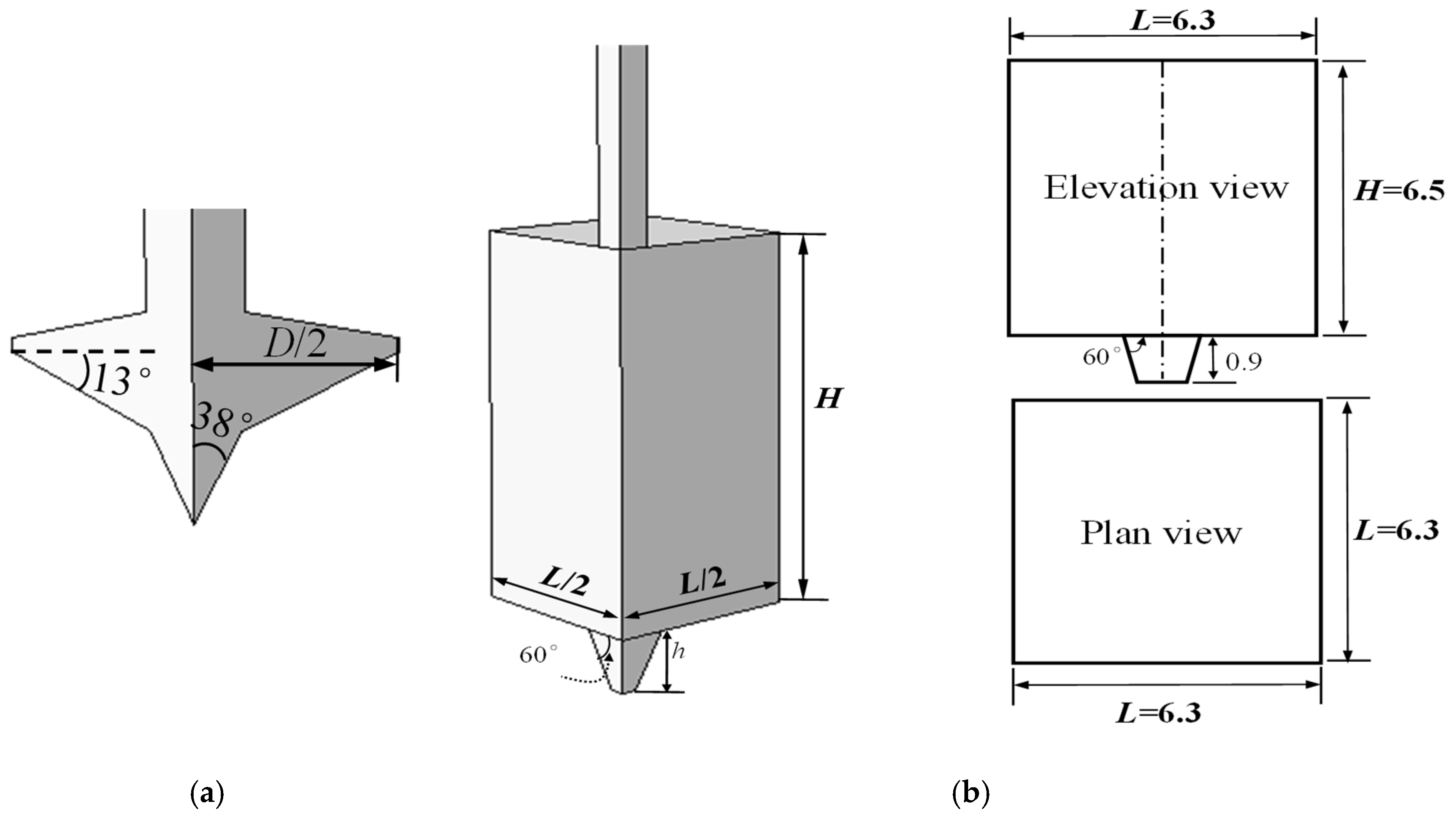

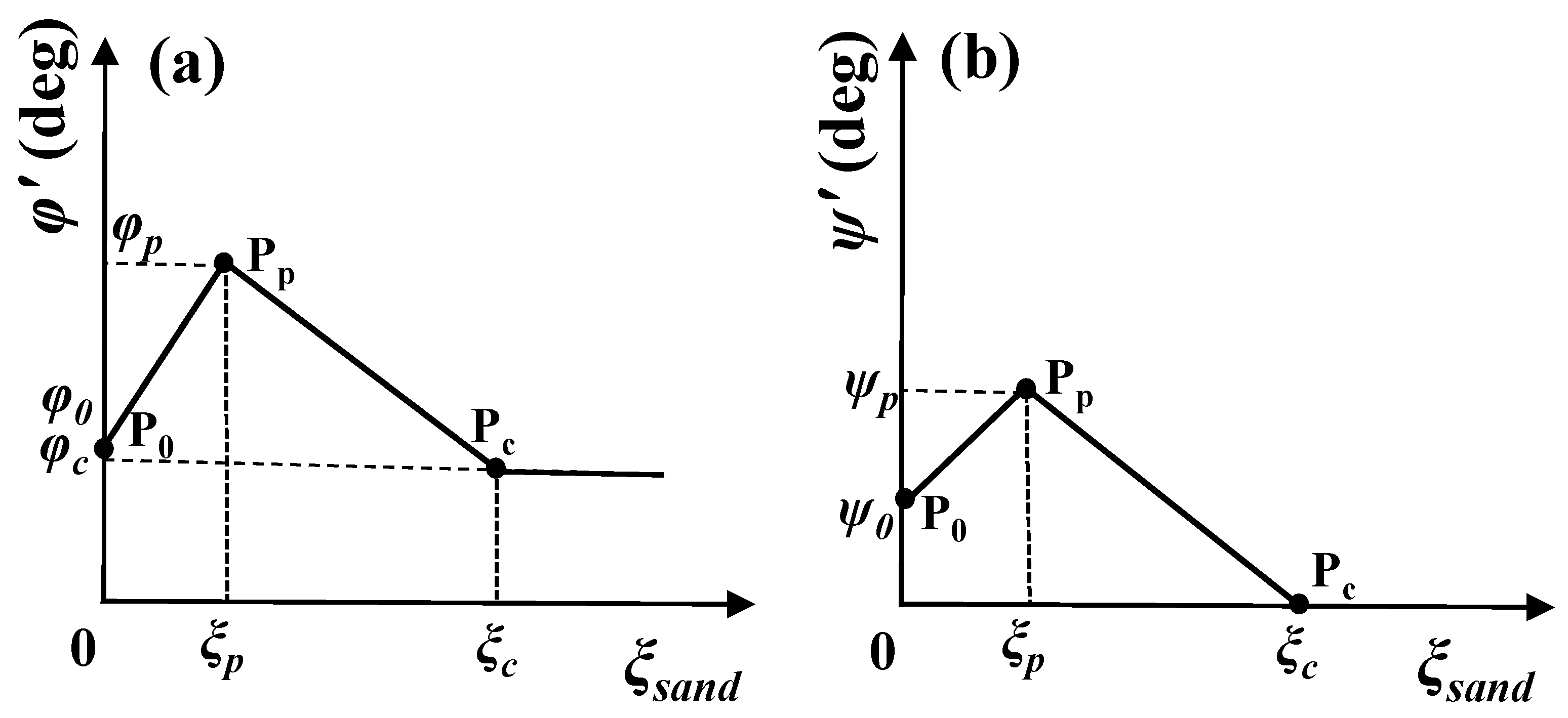
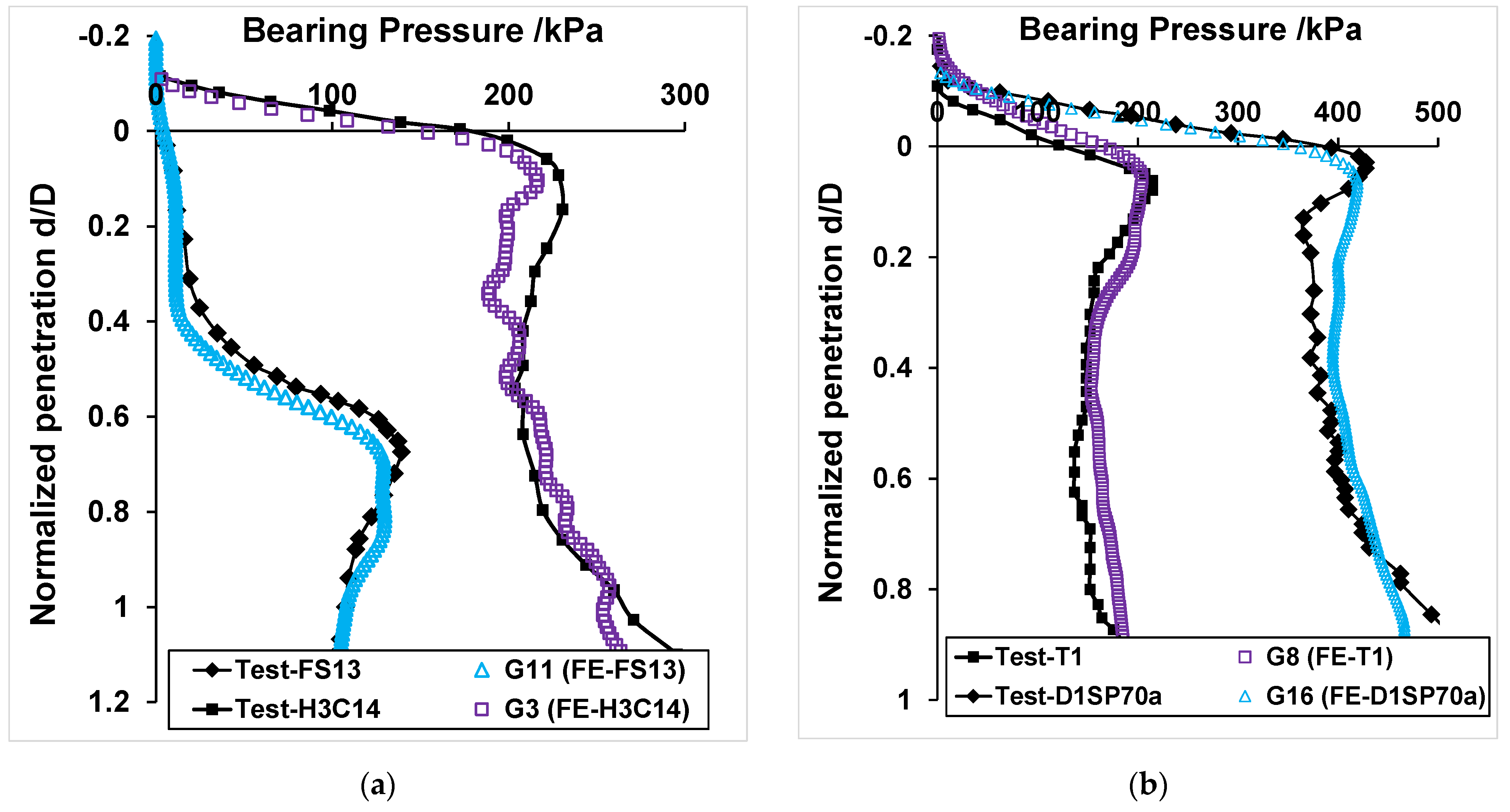
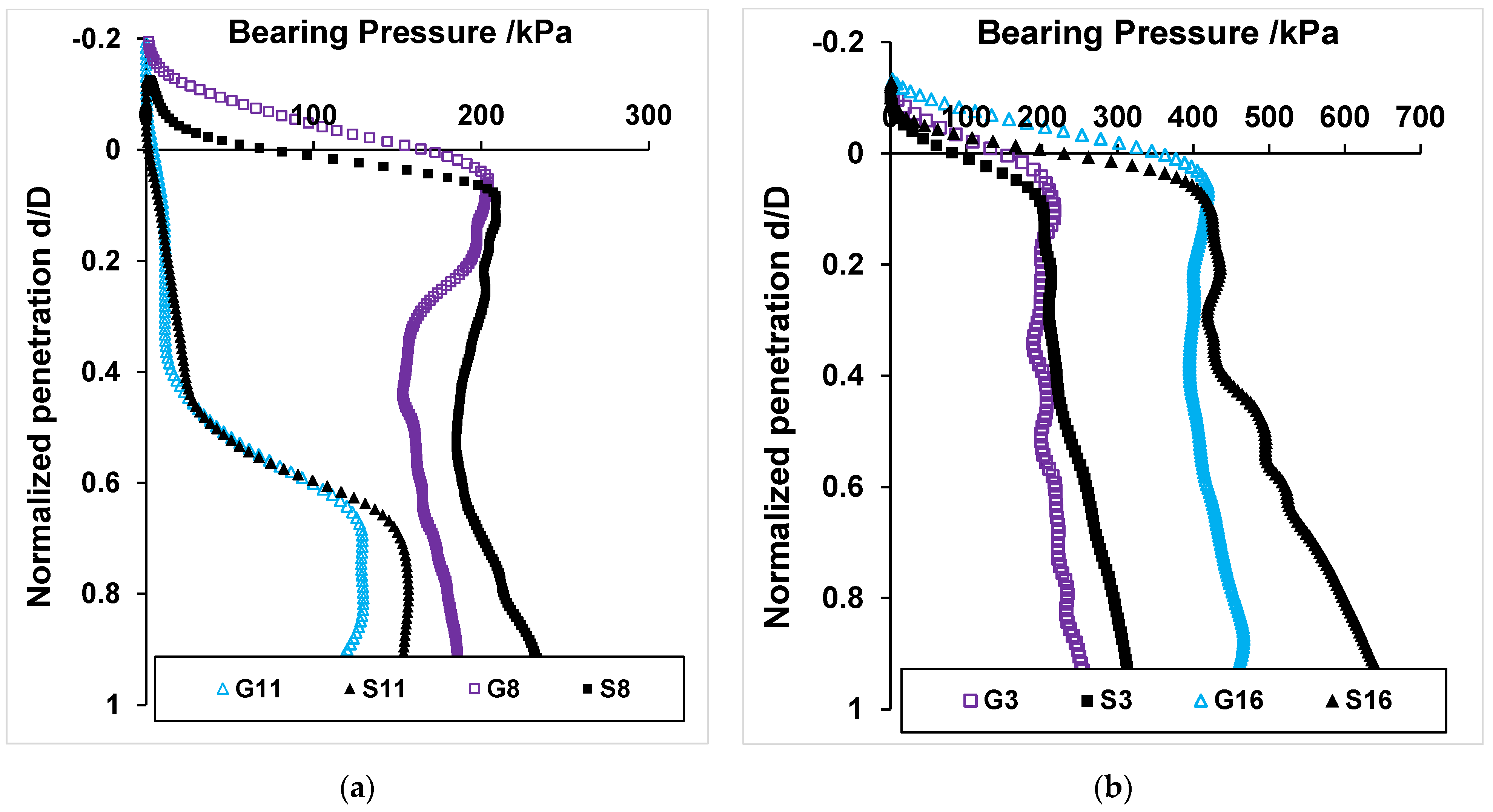

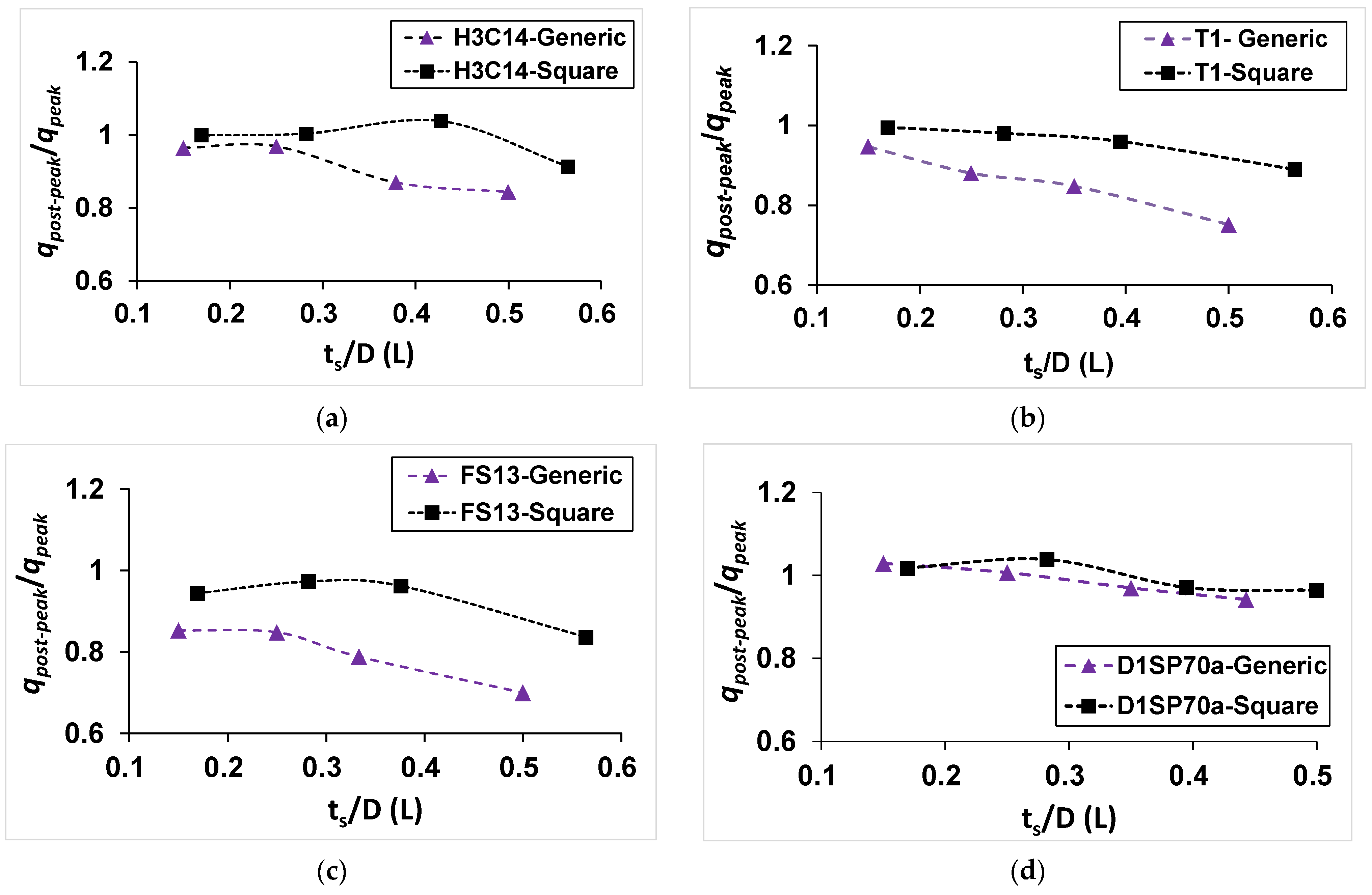
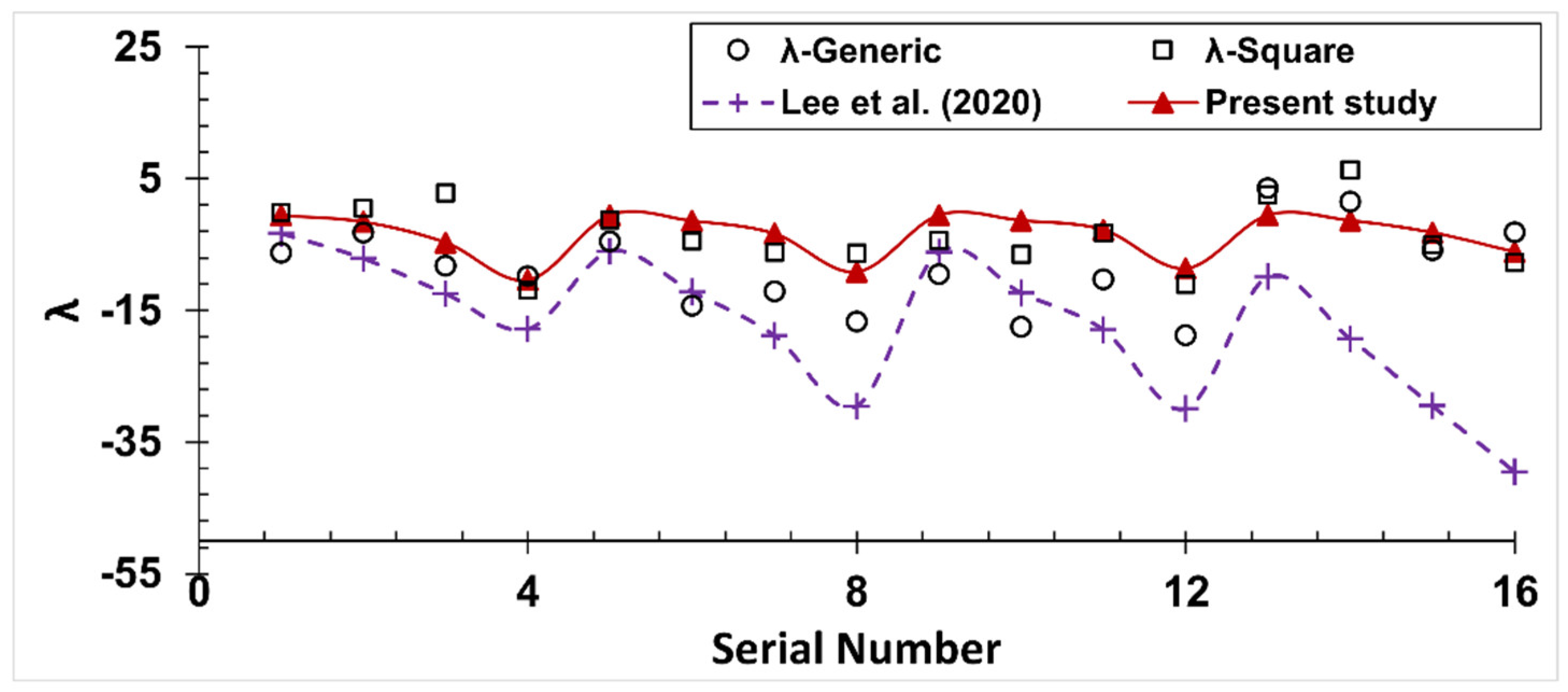
| Test | 1st Layer | 2nd Layer | |||||||
|---|---|---|---|---|---|---|---|---|---|
| T1 (D = 6 m) | t1(m) | ID (%) | φc (°) | (kN/m3) | sum (kPa) | (kN/m3) | k (kPa/m) | Teh et al. [4] | |
| 3 | 85 | 34 | 10.8 | 6.0 | 6.5 | 1.2 | |||
| D1SP70a (D = 14 m) | 1st layer | 2nd layer | Lee et al. [8] | ||||||
| t1(m) | ID (%) | φc (°) | (kN/m3) | sum (kPa) | (kN/m3) | k (kPa/m) | |||
| 6.2 | 92 | 31 | 11.0 | 17.7 | 7.5 | 2.1 | |||
| H3C14 (D = 8 m) | 1st layer | 2nd layer | Hu [13] | ||||||
| t1(m) | ID (%) | φc (°) | (kN/m3) | sum (kPa) | (kN/m3) | k (kPa/m) | |||
| 3.03 | 74 | 31 | 10.6 | 11.31 | 6.5 | 1.51 | |||
| FS13 (D = 6 m) | 1st layer | 2nd layer | Hossain [10] | ||||||
| t1(m) | sum (kPa) | (kN/m3) | k1 (kPa/m) | t2(m) | ID (%) | φ (°) | (kN/m3) | ||
| 3.7 | 0.5 | 6.5 | 0.75 | 2 | 89 | 34 | 10.0 | ||
| 3rd layer | |||||||||
| t3(m) | sum (kPa) | (kN/m3) | k3 (kPa/m) | ||||||
| 20.8 | 4.775 | 6.5 | 0.75 | ||||||
| Test | Serial Number | Name | Sand | Clay | ||||
|---|---|---|---|---|---|---|---|---|
| ts (m) | D (L) (m) | sum (kPa) | k (kPa/m) | |||||
| H3C14 | 1 | G1 | 1.2 | 8 | 0.01 | 0.4 | 11.31 | 1.51 |
| S1 | 7.09 | |||||||
| 2 | G2 | 2 | 8 | |||||
| S2 | 7.09 | |||||||
| 3 | G3 | 3.03 | 8 | |||||
| S3 | 7.09 | |||||||
| 4 | G4 | 4 | 8 | |||||
| S4 | 7.09 | |||||||
| T1 | 5 | G5 | 0.9 | 6 | 0.01 | 0.4 | 6 | 1.2 |
| S5 | 5.32 | |||||||
| 6 | G6 | 1.5 | 6 | |||||
| S6 | 5.32 | |||||||
| 7 | G7 | 2.1 | 6 | |||||
| S7 | 5.32 | |||||||
| 8 | G8 | 3 | 6 | |||||
| S8 | 5.32 | |||||||
| FS13 | 9 | G9 | 0.9 | 6 | 0.01 | 0.23 | 4.775 | 0.75 |
| S9 | 5.32 | |||||||
| 10 | G10 | 1.5 | 6 | |||||
| S10 | 5.32 | |||||||
| 11 | G11 | 2 | 6 | |||||
| S11 | 5.32 | |||||||
| 12 | G12 | 3 | 6 | |||||
| S12 | 5.32 | |||||||
| D1SP70a | 13 | G13 | 2.1 | 14 | 0 | 0.1 | 17.7 | 2.1 |
| S13 | 12.41 | |||||||
| 14 | G14 | 3.5 | 14 | |||||
| S14 | 12.41 | |||||||
| 15 | G15 | 4.9 | 14 | |||||
| S15 | 12.41 | |||||||
| 16 | G16 | 6.2 | 14 | |||||
| S16 | 12.41 | |||||||
Publisher’s Note: MDPI stays neutral with regard to jurisdictional claims in published maps and institutional affiliations. |
© 2022 by the authors. Licensee MDPI, Basel, Switzerland. This article is an open access article distributed under the terms and conditions of the Creative Commons Attribution (CC BY) license (https://creativecommons.org/licenses/by/4.0/).
Share and Cite
Zhao, J.; Zhang, Y.; Liu, L. On Cubic Spudcan Deep Penetration in Dense Sand Overlying Non-Uniform Clay. J. Mar. Sci. Eng. 2022, 10, 1607. https://doi.org/10.3390/jmse10111607
Zhao J, Zhang Y, Liu L. On Cubic Spudcan Deep Penetration in Dense Sand Overlying Non-Uniform Clay. Journal of Marine Science and Engineering. 2022; 10(11):1607. https://doi.org/10.3390/jmse10111607
Chicago/Turabian StyleZhao, Jun, Yang Zhang, and Luyu Liu. 2022. "On Cubic Spudcan Deep Penetration in Dense Sand Overlying Non-Uniform Clay" Journal of Marine Science and Engineering 10, no. 11: 1607. https://doi.org/10.3390/jmse10111607
APA StyleZhao, J., Zhang, Y., & Liu, L. (2022). On Cubic Spudcan Deep Penetration in Dense Sand Overlying Non-Uniform Clay. Journal of Marine Science and Engineering, 10(11), 1607. https://doi.org/10.3390/jmse10111607




